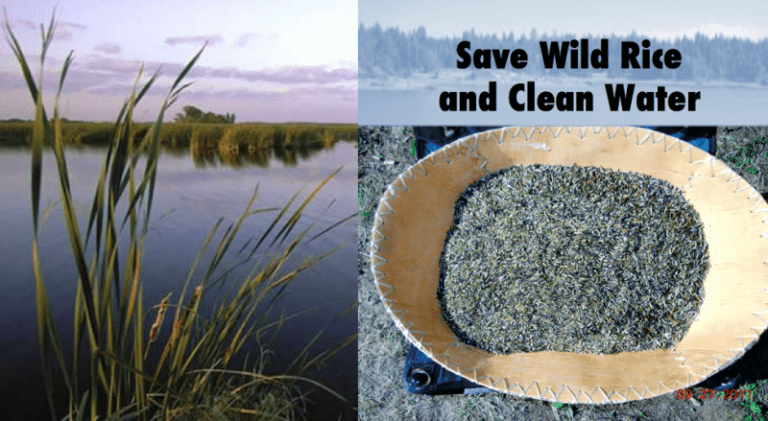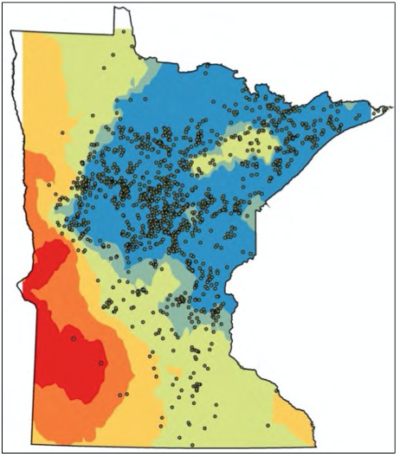Rulemaking: Wild Rice Sulfate Standard
What is the wild rice sulfate standard?

What efforts were made to weaken or eliminate the standard through rulemaking?
In 2011, the Minnesota Legislature passed a session law directing the MPCA to engage in rulemaking to amend the wild rice sulfate standard. This session law appropriated $1.5 million for new scientific research and a task force run by the MPCA, anticipating that the rule would be amended to repeal or weaken the wild rice sulfate standard. This rulemaking process took seven years – from 2011 through 2018.

What was the result of the rulemaking process?
Minnesota’s wild rice rulemaking process funded scientific research that confirmed the wild rice sulfate rule is reasonable and necessary to protect wild rice.
WaterLegacy, tribes, and independent scientists opposed MPCA’s proposed rule on several important grounds:
- MPCA’s proposed equation would fail to protect wild rice, especially in mining regions.
- Additional sulfate allowed by MPCA’s proposed rule would increase mercury methylation and contamination of fish.
- Excluding some Minnesota wild rice waters from protection would violate the federal Clean Water Act.
The wild rice rule adopted and approved in 1973 to limit sulfate to 10 parts per million (mg/L) remains in effect.
What did the Administrative Law Judge decide?
DISAPPROVED repeal of Minnesota’s existing wild rice sulfate standard of 10 mg/L, stating:
DISAPPROVED restricting the list of wild rice waters. The MPCA could list 1300 wild rice waters only if other waters where wild rice has been an existing use since November 1975 were also protected.
DISAPPROVED changing the narrative standard that protects wild rice from harm due to changes in human-made conditions, such as flooding.
DESCRIBED concerns about preventing increased mercury methylation as well as further harm to wild rice and recognized the burdens that would be placed on Native American communities if the wild rice sulfate rule were changed.
Wild Rice Sulfate Rule Timeline
2011
Feb. 2014
Sulfide is toxic to wild rice. The MPCA Study demonstrated that elevated sulfide concentrations were toxic to wild rice seedlings. Hydroponic experiment data showed deleterious effects of sulfide on seedling plant growth when sulfide exceeded the range of 150 to 300 µg/L.
Sulfide in the sediment is affected by the amount of sulfate in the water column, and the amount of iron in the sediment.
The 10 mg/L sulfate standard is needed and reasonable to protect wild rice production from sulfate‐ driven sulfide toxicity. The MPCA will also consider including a sediment sulfide concentration as a component of this water quality standard, in the range of 150 to 300 µg/L sulfide.
The 10 mg/L wild rice sulfate standard should continue to apply to both lakes and streams.
MPCA internal emails reveal that MPCA presented these findings and recommendations to a group of Iron Range legislators prior to their planned release. The day before the findings were set for release to the public, the Governor’s staff wrote, “This is a big deal and it is blowing up this morning.” MPCA’s Commissioner agreed, “the meeting with range legislators went poorly.” According to MPCA staff, the “plug got pulled” on support of the existing standard. After February 2014, MPCA no longer supported Minnesota’s existing rule limiting sulfate in wild rice waters to 10 mg/L.
June 2014

2015
2016
2017
MPCA’s proposed rule did not resolve the concerns raised by WaterLegacy, tribes, and independent scientists. WaterLegacy submitted a total of 2,406 citizen petitions, letters, and postcards opposing the MPCA’s proposal to eliminate the 10 mg/L wild rice sulfate standard and arbitrarily restrict wild rice waters.
WaterLegacy also testified and submitted 1400 pages of comments, exhibits, and expert opinions opposing MPCA’s proposed rule as unreasonable, arbitrary, inconsistent with science, unprotective of wild rice, and in violation of the Clean Water Act.
(Exhibits available on request)
2018

